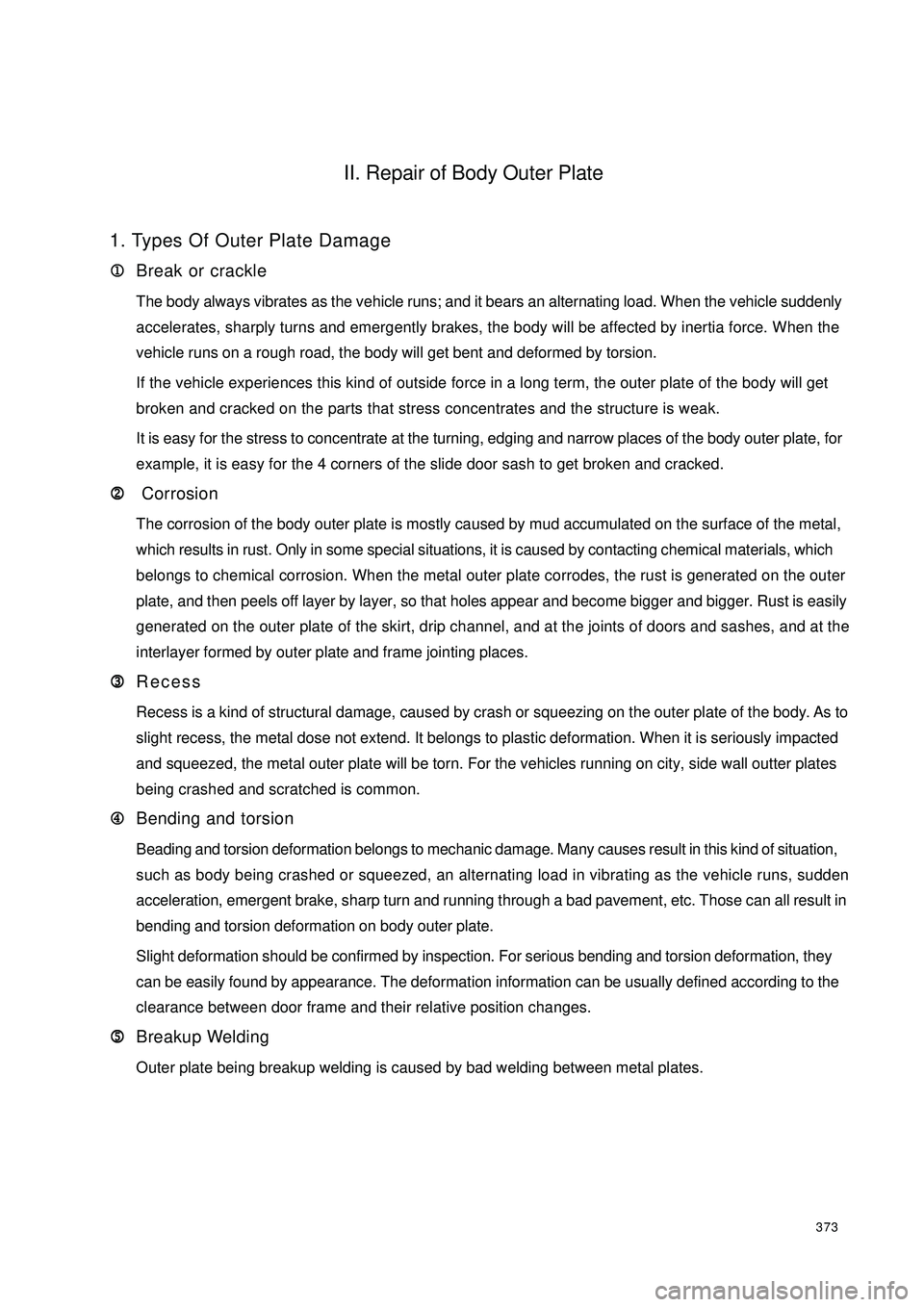light GEELY CK 2008 Repair Manual
[x] Cancel search | Manufacturer: GEELY, Model Year: 2008, Model line: CK, Model: GEELY CK 2008Pages: 392, PDF Size: 38.86 MB
Page 380 of 392

373II. Repair of Body Outer Plate1. Types Of Outer Plate Damage
1 11 1
1Break or crackle
The body always vibrates as the vehicle runs; and it bears an alternating load. When the vehicle suddenly
accelerates, sharply turns and emergently brakes, the body will be affected by inertia force. When the
vehicle runs on a rough road, the body will get bent and deformed by torsion.
If the vehicle experiences this kind of outside force in a long term, the outer plate of the body will get
broken and cracked on the parts that stress concentrates and the structure is weak.
It is easy for the stress to concentrate at the turning, edging and narrow places of the body outer plate, for
example, it is easy for the 4 corners of the slide door sash to get broken and cracked.
2 22 2
2 Corrosion
The corrosion of the body outer plate is mostly caused by mud accumulated on the surface of the metal,
which results in rust. Only in some special situations, it is caused by contacting chemical materials, which
belongs to chemical corrosion. When the metal outer plate corrodes, the rust is generated on the outer
plate, and then peels off layer by layer, so that holes appear and become bigger and bigger. Rust is easily
generated on the outer plate of the skirt, drip channel, and at the joints of doors and sashes, and at the
interlayer formed by outer plate and frame jointing places.
3 33 3
3Recess
Recess is a kind of structural damage, caused by crash or squeezing on the outer plate of the body. As to
slight recess, the metal dose not extend. It belongs to plastic deformation. When it is seriously impacted
and squeezed, the metal outer plate will be torn. For the vehicles running on city, side wall outter plates
being crashed and scratched is common.
4 44 4
4Bending and torsion
Beading and torsion deformation belongs to mechanic damage. Many causes result in this kind of situation,
such as body being crashed or squeezed, an alternating load in vibrating as the vehicle runs, sudden
acceleration, emergent brake, sharp turn and running through a bad pavement, etc. Those can all result in
bending and torsion deformation on body outer plate.
Slight deformation should be confirmed by inspection. For serious bending and torsion deformation, they
can be easily found by appearance. The deformation information can be usually defined according to the
clearance between door frame and their relative position changes.
5 55 5
5Breakup Welding
Outer plate being breakup welding is caused by bad welding between metal plates.
Page 382 of 392

375At the beginning of knocking it, make your force slightly greater. In the finishing period of repair, make
your force softer and try your best to reduce the beating times. Make sure not to knock one point for too
many times to avoid extending on partial area of the metal plate, which may make the repair complex.
As to the concave with a comparatively big radian, a backing plate whose area should be comparatively
big can be put under the center of the concave. Directly push up the depressed plate by a propping-up
tool. Sometimes, the concave place can be heated to dark red to reduce the pushing force. A slight rise is
recommended when pushing up. (Figure 5-20)
Heat-shrinkable method:
After the concave area is pushed up, if the plate is greatly stretched and its area is too big to repair, the
heat-shrinkable method can be adopted.
Use oxygen-acetylene flame to heat to cherry red. The area of heating depends to its extension degree.
The heating area should be bigger (Diameter approx. 20-30mm), when it is seriously extended or the area
is big. If it is slightly extended or the area is small, the heating area should be smaller (Diameter approx.
10-15mm). Quickly knock the heated points with a wooden hammer while they are hot. A backing block
is recommended to push it up. After it cools down, use an iron hammer to gently knock for smoothness.
The shrinkage order is from the highest point gradually to the center and then to the edge. Heat and then
flatten the extended area repeatedly, till the plate is completely flat. If the protrusion is very high, first
compress the whole protrusion to its half. After it cools down, heat the former heating point to remove the
rest half of the protrusion.
When the method is applied, it must be specially noted that you'd better not use the heat-shrinkage
method to avoid side effects. Especially for thin plates, prevent them from being melted through hole..
When the outer plate is lightly crashed and the depressed area belongs to elastic deformation, you may
press its inside to recover to its former shape.
Some depressed area can be repair by prying which is a repair method without disassembling parts. YouIllustration 5-18 Panel Flattening (A)
A Concave Point B Protrusion Point C Knocking PointIllustration 5-19 Panel Flattening (B)
1 Hammer 2 Panel Parts 3 Backing BlockFigure 5-20 Heat and flatten the protrusion
1 heating point